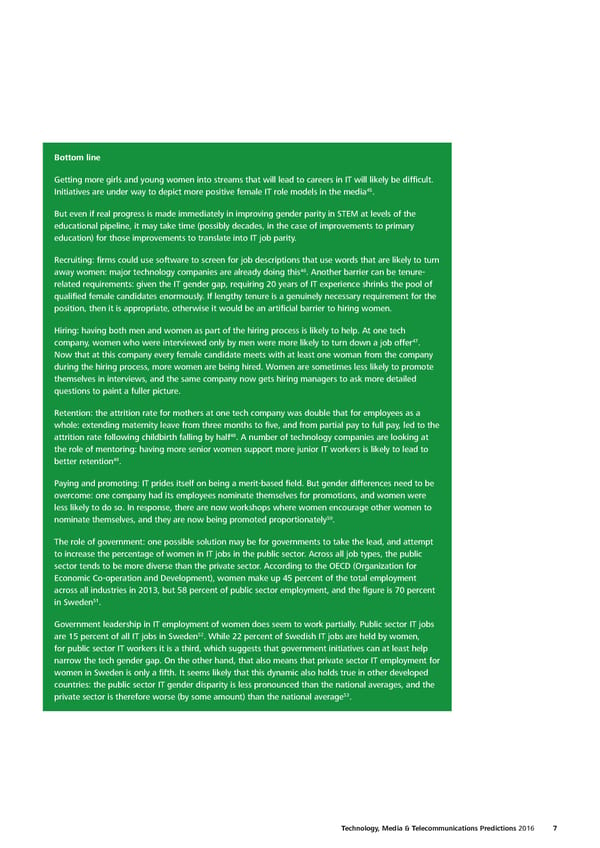Bottom line Getting more girls and young women into streams that will lead to careers in IT will likely be difficult. 45 Initiatives are under way to depict more positive female IT role models in the media . But even if real progress is made immediately in improving gender parity in STEM at levels of the educational pipeline, it may take time (possibly decades, in the case of improvements to primary education) for those improvements to translate into IT job parity. Recruiting: firms could use software to screen for job descriptions that use words that are likely to turn 46 away women: major technology companies are already doing this . Another barrier can be tenure- related requirements: given the IT gender gap, requiring 20 years of IT experience shrinks the pool of qualified female candidates enormously. If lengthy tenure is a genuinely necessary requirement for the position, then it is appropriate, otherwise it would be an artificial barrier to hiring women. Hiring: having both men and women as part of the hiring process is likely to help. At one tech 47 company, women who were interviewed only by men were more likely to turn down a job offer . Now that at this company every female candidate meets with at least one woman from the company during the hiring process, more women are being hired. Women are sometimes less likely to promote themselves in interviews, and the same company now gets hiring managers to ask more detailed questions to paint a fuller picture. Retention: the attrition rate for mothers at one tech company was double that for employees as a whole: extending maternity leave from three months to five, and from partial pay to full pay, led to the 48 attrition rate following childbirth falling by half . A number of technology companies are looking at the role of mentoring: having more senior women support more junior IT workers is likely to lead to 49 better retention . Paying and promoting: IT prides itself on being a merit-based field. But gender differences need to be overcome: one company had its employees nominate themselves for promotions, and women were less likely to do so. In response, there are now workshops where women encourage other women to 50 nominate themselves, and they are now being promoted proportionately . The role of government: one possible solution may be for governments to take the lead, and attempt to increase the percentage of women in IT jobs in the public sector. Across all job types, the public sector tends to be more diverse than the private sector. According to the OECD (Organization for Economic Co-operation and Development), women make up 45 percent of the total employment across all industries in 2013, but 58 percent of public sector employment, and the figure is 70 percent 51 in Sweden . Government leadership in IT employment of women does seem to work partially. Public sector IT jobs 52 are 15 percent of all IT jobs in Sweden . While 22 percent of Swedish IT jobs are held by women, for public sector IT workers it is a third, which suggests that government initiatives can at least help narrow the tech gender gap. On the other hand, that also means that private sector IT employment for women in Sweden is only a fifth. It seems likely that this dynamic also holds true in other developed countries: the public sector IT gender disparity is less pronounced than the national averages, and the 53 private sector is therefore worse (by some amount) than the national average . Technology, Media & Telecommunications Predictions 2016 7
 Technology, Media & Telecommunications Predictions Page 11 Page 13
Technology, Media & Telecommunications Predictions Page 11 Page 13